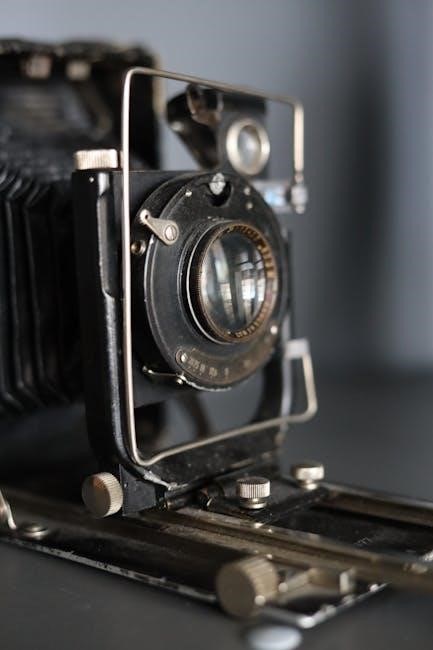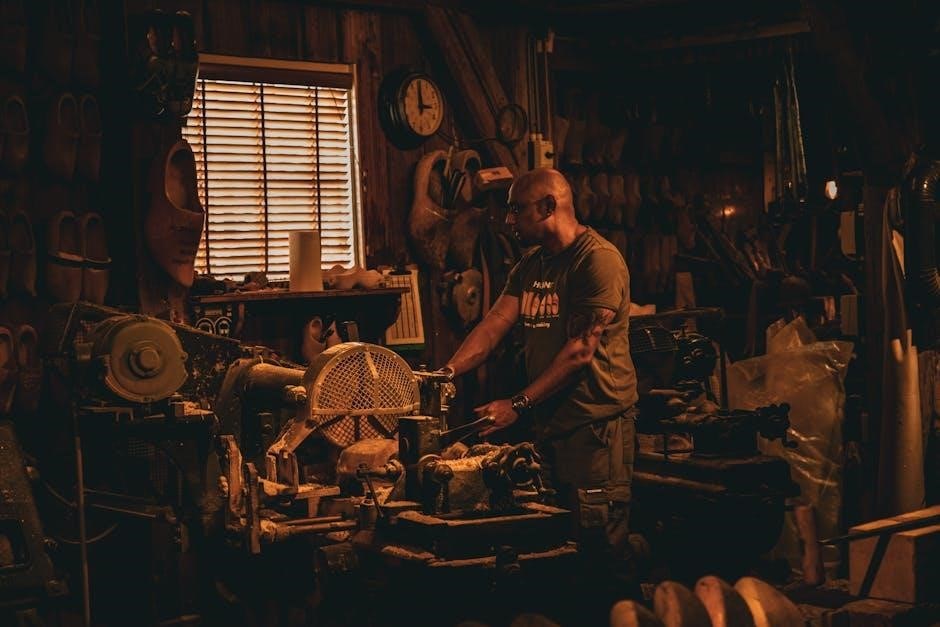The Lexus IS300 manual swap transforms the driving experience, offering enhanced control and engagement․ This complex yet rewarding modification replaces the automatic transmission with a manual setup, typically using the W58 transmission․ Enthusiasts pursue this swap for improved performance, cost savings, and a more immersive driving connection, supported by a vibrant community and detailed guides․
Overview of the IS 300 Model
The Lexus IS 300, produced from 2001 to 2005, is a sport sedan known for its sleek design and robust performance; It features a 3․0L inline-six engine, delivering smooth power and refinement․ Originally available with an automatic transmission, the IS 300 gained popularity among enthusiasts for its potential for modification, particularly manual swaps․ Its rear-wheel-drive layout and well-balanced chassis make it an ideal candidate for such upgrades․ The model’s compact size, luxurious interior, and reliable engineering have made it a favorite for drivers seeking a blend of comfort and driving excitement․ These qualities, combined with its tunability, have solidified the IS 300’s reputation as a versatile and desirable vehicle for enthusiasts․
Why Consider a Manual Swap?
Manual swaps offer drivers enhanced control and a more engaging experience behind the wheel․ For IS 300 owners, transitioning from an automatic to a manual transmission can improve fuel efficiency and reduce maintenance costs․ This modification allows for better acceleration and responsiveness, making it particularly appealing for enthusiasts who value performance and precision․ Additionally, the manual swap can increase the car’s resale value among driving purists․ While the process is complex and requires specialized tools and expertise, the rewards of a more dynamic and rewarding driving experience make it a worthwhile investment for many․ This swap is especially popular in communities where driving enthusiasts seek to personalize and optimize their vehicles for both style and function․

History and Background of Manual Swaps
Manual swaps have gained popularity among IS 300 enthusiasts, driven by the desire for improved performance and driving engagement; The trend originated from community-driven projects and aftermarket solutions, evolving into a well-documented process supported by specialized kits and forums․ This modification reflects the broader automotive culture of personalization and optimization, with the IS 300 becoming a prime candidate for manual transmission conversions due to its robust engine and chassis design․
Evolution of Manual Transmissions in Lexus Models
Lexus, traditionally known for its luxurious automatic transmissions, has seen a growing interest in manual swaps among enthusiasts․ The IS 300, despite being offered with an automatic, has become a prime candidate for manual conversions․ The W58 transmission, often sourced from Toyota’s performance lineage, has emerged as a popular choice for its durability and smooth shifting․ This trend reflects a broader shift in the automotive community toward driver engagement and control․ While Lexus never offered a factory manual IS 300 in most markets, the aftermarket and DIY movements have filled this gap, providing detailed guides and parts solutions․ This evolution underscores the blend of luxury and performance that defines the IS 300’s appeal․
Community Contributions and Popular Trends
The IS 300 manual swap has gained significant traction within enthusiast communities, driven by shared knowledge and collaborative efforts․ Online forums and YouTube channels provide detailed guides, while enthusiasts openly share their experiences, creating a wealth of resources․ The swap’s popularity has grown as owners seek to enhance performance and driving engagement․ Many have documented their journeys, offering insights into parts selection, installation challenges, and troubleshooting․ This collective effort has streamlined the process, making it more accessible for newcomers․ Additionally, the availability of swap kits and OEM-compatible components has further fueled the trend, inspiring even more owners to take on the project and join the community of manual-swapped IS 300s․

Benefits of Manual Transmission
Upgrading to a manual transmission enhances driving engagement, improves fuel economy, and reduces long-term maintenance costs, while offering a more connected and cost-effective driving experience․
Enhanced Driving Experience
A manual swap in the IS300 elevates driving engagement, offering a more connected and immersive experience․ Drivers gain precise control over gear shifts, enabling smoother acceleration and tighter handling․ The direct connection to the vehicle’s mechanics fosters a sense of mastery, making every drive feel purposeful and enjoyable․ This upgrade transforms the IS300 into a driver-centric machine, perfect for enthusiasts seeking a more dynamic and responsive ride․ The thrill of manual driving reignites passion for the road, making the swap a rewarding choice for those who value driving involvement and satisfaction․ This enhanced experience is a key motivator for many pursuing the manual swap, blending performance and personal fulfillment․
Improved Fuel Efficiency
A manual swap in the IS300 can lead to improved fuel efficiency, especially in city driving and hilly terrain․ By providing better control over gear shifts, drivers can optimize acceleration and deceleration, reducing unnecessary fuel consumption․ Manual transmissions typically have fewer parasitic losses compared to automatics, contributing to better mileage․ Additionally, the engagement of driving a manual often encourages smoother, more efficient driving habits․ While results may vary depending on driving style and conditions, many owners report noticeable improvements in fuel economy post-swap․ This makes the manual swap a practical choice for those seeking both performance and cost savings․ The combination of enhanced control and reduced fuel waste makes the IS300 manual swap a compelling option for efficiency-minded enthusiasts․
Better Control and Performance
A manual swap in the IS300 enhances driving control and performance, offering a more engaging experience․ Drivers gain precise command over gear shifts, enabling better acceleration and responsiveness․ The direct connection between the driver and the vehicle fosters a more immersive driving experience, particularly appealing to enthusiasts․ Manual transmissions often deliver crisper throttle response and quicker power delivery compared to automatics․ Additionally, the ability to downshift for braking control improves handling and stability․ This swap transforms the IS300 into a more driver-focused machine, making it ideal for spirited driving․ The enhanced control and performance capabilities make the manual swap a popular choice among car enthusiasts seeking a more dynamic and precise driving experience․

Key Components Needed for the Swap
The IS300 manual swap requires essential components like a W58 transmission, clutch setup, pedal assembly, and additional hardware for a successful conversion to manual control․
Transmission Type (W58)
The W58 transmission is a popular choice for the IS300 manual swap due to its durability and compatibility with the Lexus engine․ This 5-speed manual gearbox is known for its smooth shifting and robust construction, making it ideal for both daily driving and performance applications․ The W58 is often sourced from other Lexus or Toyota models, ensuring OEM reliability․ Proper installation requires precise alignment and mounting to maintain optimal performance․ Additionally, it may need modifications to fit seamlessly with the IS300’s chassis and drivetrain․ The W58’s proven track record in swaps makes it a preferred option among enthusiasts for achieving a reliable and responsive manual driving experience․
Clutch Setup and Components
A proper clutch setup is essential for a successful IS300 manual swap․ The clutch kit, including the clutch disc, pressure plate, and bearing, must be compatible with the W58 transmission․ A lightweight flywheel is often recommended to improve throttle response and reduce rotational mass․ The clutch slave cylinder and master cylinder are critical for smooth pedal operation․ Ensuring these components are properly aligned and installed is vital for optimal performance․ Many enthusiasts opt for OEM or high-performance aftermarket parts to maintain reliability and durability․
Additionally, the clutch pedal assembly must be correctly integrated with the manual transmission․ This ensures precise control over the clutch engagement, which is crucial for smooth shifting and preventing wear on the components․ Proper installation and adjustment of these parts are key to achieving a seamless driving experience․
Clutch Pedal Assembly
The clutch pedal assembly is a critical component in the IS300 manual swap, enabling smooth and precise control over the clutch system․ Installing a clutch pedal kit specifically designed for the IS300 is essential, as it ensures compatibility with the manual transmission․ The pedal assembly typically includes the pedal itself, linkage, and necessary brackets․ Proper installation involves mounting the pedal assembly in the driver’s footwell and connecting it to the clutch master cylinder․ Relocating or modifying the handbrake assembly may be required to accommodate the new pedal setup․ Ensuring the clutch pedal operates smoothly and consistently is vital for seamless shifting and optimal driving performance․ Many enthusiasts opt for OEM or aftermarket kits to maintain reliability and ease of installation․
Other Essential Hardware
Beyond the transmission and clutch setup, several other components are crucial for a successful IS300 manual swap․ The driveshaft must be compatible with the new manual transmission, often requiring modification or replacement․ Center-support spacers may need adjustment to ensure proper driveshaft alignment․ Additionally, the crossmember and mounting points should be inspected and reinforced to handle the manual transmission’s stress․ A shifter assembly, including the shift knob and linkage, is necessary for precise gear control․ Brake and clutch fluid lines may also require modification to integrate with the manual system․ Finally, ensuring all hardware is compatible with the IS300’s chassis and engine is vital for a seamless swap and reliable performance․

Step-by-Step Installation Guide
Begin by removing the automatic transmission, followed by installing the manual unit․ Ensure proper alignment and reconnection of essential components like driveshaft and hydraulic lines․ Precision is key․
Preparation and Tools Required
Before starting the IS300 manual swap, gather essential tools and materials․ A well-equipped workspace with a lift or jack stands is crucial for safety and accessibility․ Tools include wrenches, socket sets, screwdrivers, and specialized equipment like a transmission jack․ Drain the automatic transmission fluid and remove components such as the driveshaft and shift control rod․ Collect necessary parts like the W58 transmission, clutch setup, and pedal assembly․ OEM components are recommended for compatibility․ A detailed step-by-step guide or experienced mentor can help navigate the process efficiently․ Ensure all parts are inspected and ready to minimize delays․ Proper preparation ensures a smoother and less stressful installation process․
Removing the Automatic Transmission
Removing the automatic transmission from your IS300 is a critical step in the manual swap process․ Begin by draining the transmission fluid to prevent any leaks․ Locate the drain plug, typically found at the bottom of the transmission pan, and allow the fluid to flow into a drip pan․ Next, disconnect the shift control rod, which links the gear shifter to the transmission, ensuring it’s free from obstructions․ Carefully remove the driveshaft, marking its position with paint or a marker for proper realignment later․ Be cautious, as the driveshaft can be heavy․ Afterward, disconnect all electrical connectors and sensors attached to the transmission to avoid damaging the wiring․ Remove the filler pipe and dipstick tube to clear the area․ Finally, use a transmission jack to safely lift and remove the transmission, ensuring the car is securely supported to prevent accidents․ Having a helper can be beneficial for this heavy and delicate task․ Always refer to a repair manual or seek guidance from online forums if unsure about any step․
Installing the Manual Transmission
Installing the manual transmission is the most challenging part of the swap․ Begin by aligning the W58 transmission with the engine, ensuring it fits securely into the bellhousing․ Use a transmission jack for precise control and safety․ Once aligned, bolt the transmission to the engine, following the manufacturer’s torque specifications to avoid damage․ Reattach the driveshaft, ensuring it is properly aligned to prevent vibration․ Connect the hydraulic clutch slave cylinder to the transmission, bleeding the system to remove air bubbles․ Reinstall any necessary brackets or mounts, and reconnect the gear shifter linkages․ Double-check all connections, including electrical sensors, to ensure proper functionality․ Finally, test the transmission by shifting through gears to confirm smooth operation before reinstalling the center console and other components․
Electrical and Hydraulic Connections
After installing the manual transmission, focus on establishing the electrical and hydraulic connections․ Begin by connecting the wiring harness to the transmission, ensuring all sensors and solenoids are properly linked․ The reverse light switch and gear position sensor must be connected to maintain proper functionality․ For the hydraulic system, install the clutch master cylinder on the clutch pedal assembly, routing the hydraulic line to the slave cylinder attached to the transmission․ Bleed the hydraulic system thoroughly to eliminate air bubbles, ensuring smooth clutch engagement․ Double-check all electrical connections to prevent issues with the ECU or transmission sensors․ Finally, test the clutch pedal feel and gear shifting to confirm everything operates seamlessly before completing the installation․

Wiring and Electronics
Understanding the wiring harness is crucial for integrating the manual transmission․ Reprogramming the ECU ensures compatibility with the new setup․ Install necessary electrical components like clutch pedals and sensors․
Understanding the Wiring Harness
Understanding the wiring harness is essential for a smooth manual swap․ The harness connects the transmission to the car’s electronics, controlling functions like gear selection and clutch engagement․ For an IS300, you’ll need to identify and adapt the wiring for the clutch pedal, gear position sensor, and reverse light switch․ These components ensure the ECU communicates properly with the manual transmission․ Proper wiring prevents errors and ensures all systems function seamlessly; Consulting a detailed wiring diagram or an expert is recommended to avoid complications during installation․
ECU Reprogramming and Integration
ECU reprogramming is critical for integrating the manual transmission into the IS300’s system․ The ECU must be updated to recognize the new components, such as the clutch pedal and gear position sensor․ This ensures proper communication between the engine and transmission for smooth operation․ Reprogramming typically involves reflashing the ECU with custom software or using a tuning tool to remove automatic transmission dependencies․ It’s essential to work with a qualified tuner familiar with Lexus systems to avoid errors․ Proper integration ensures the car runs optimally, with features like reverse light activation and correct gear display functioning as intended․ This step is vital for a seamless manual swap experience and is often done alongside wiring harness modifications․ Consulting a professional is highly recommended to avoid costly mistakes․

Cost and Considerations
The IS300 manual swap involves significant costs, including the transmission, clutch, and pedal assembly․ Labor expenses add to the total, varying based on parts sourcing and mechanic rates․
Estimated Total Cost
The estimated total cost for an IS300 manual swap varies widely based on parts and labor․ The W58 transmission itself can range from $1,500 to $3,000, depending on condition and source․ A clutch setup, including the clutch disc, pressure plate, and flywheel, typically costs $500 to $1,000․ The clutch pedal assembly and hydraulic components add another $300 to $800․ Additional hardware, such as the driveshaft, crossmember, and shifter, can add up to $500․ Labor costs for a professional mechanic or specialist can range from $1,500 to $3,000, depending on complexity and location․ Overall, the total cost for a professional swap is approximately $4,300 to $7,300․ DIY enthusiasts may save on labor, but parts alone still total around $2,500 to $4,500․ Additional expenses, such as transmission mounts, hydraulic lines, and potential ECU reprogramming, should also be considered;
Assessing the Value of the Swap

The IS300 manual swap offers significant value for enthusiasts seeking enhanced driving engagement and performance․ By converting to a manual transmission, drivers gain better control and a more immersive experience, often justifying the investment․ The swap can also appreciate the car’s value among enthusiasts, as manual transmissions are highly sought after in the Lexus community․ Additionally, the cost savings from improved fuel efficiency and potential reduced maintenance costs over time add to the swap’s overall value․ While the upfront cost is substantial, the long-term benefits and personal satisfaction make it a worthwhile investment for many․ Community support and readily available guides further enhance the value, making the swap a popular choice for IS300 owners․

Troubleshooting Common Issues
Common issues after an IS300 manual swap include clutch alignment problems, hydraulic leaks, and wiring connectivity errors․ Diagnosing these early ensures a smoother transition to manual driving․
Diagnosing Post-Swap Problems
Diagnosing post-swap issues in an IS300 manual conversion requires a systematic approach․ Start by checking the clutch pedal feel and transmission engagement for smooth operation․ Listen for unusual noises, such as grinding or clunking, which may indicate misaligned gears or worn components․ Inspect the hydraulic system for leaks, as this can lead to inconsistent clutch performance․ Review the wiring connections to ensure proper communication between the ECU and the manual transmission components․ If the car hesitates or stalls, it could point to a problem with the clutch slave cylinder or master cylinder․ Always refer to the troubleshooting guides and forums for common issues and solutions shared by the IS300 community․
Resolving Common Issues
Resolving common issues post-manual swap in an IS300 often involves addressing clutch and transmission-related problems․ If the clutch feels spongy or inconsistent, bleed the hydraulic system to ensure proper fluid flow․ For grinding gears, check the transmission alignment and adjust the shifter linkage․ Noisy operation may require replacing worn bearings or synchros․ Electrical issues, such as erratic clutch engagement, can be resolved by verifying wiring connections and ensuring the ECU is properly reprogrammed․ Consult online forums and repair guides for specific solutions, as the IS300 community frequently shares detailed fixes․ Regular maintenance, such as inspecting the clutch slave cylinder and transmission mounts, can prevent many issues from arising․

Community and Support
The IS300 manual swap community offers extensive support through online forums, social media groups, and specialized websites․ Enthusiasts share detailed guides, troubleshooting tips, and personal experiences․
Online Forums and Resources
Online forums and communities are invaluable for IS300 manual swap projects․ Platforms like Reddit’s IS300 subreddit, specialized Lexus forums, and Facebook groups provide detailed guides, troubleshooting tips, and real-world experiences․ Enthusiasts share step-by-step instructions, parts lists, and advice, helping owners navigate the swap․ YouTube channels offer video tutorials, showcasing the process from start to finish․ Additionally, websites dedicated to Lexus modifications host comprehensive resources, including wiring diagrams and installation tips․ These resources foster collaboration, enabling owners to overcome challenges and achieve successful swaps․ The collective knowledge of the community ensures that even complex issues can be addressed effectively, making the manual swap more accessible for enthusiasts of all skill levels․ This support network is crucial for a smooth and rewarding project experience․
The IS300 manual swap is a transformative modification, offering a more engaging and rewarding driving experience․ While challenging, the end result is well worth the effort․
Final Thoughts and Encouragement
Embarking on an IS300 manual swap is a significant undertaking, but the rewards are substantial․ The sense of accomplishment and the enhanced driving experience make it worthwhile․ Owners should embrace the challenge with patience and thorough preparation, leveraging the wealth of online resources and community support available․ The IS300 community is active and knowledgeable, providing invaluable guidance and encouragement․ For those passionate about driving dynamics and customization, this swap is a testament to the spirit of automotive enthusiasts․ With dedication, the IS300 can become a more engaging and personalized vehicle, offering a driving experience that aligns with your passion for performance and control․